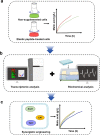Improving the productivity of malic acid by alleviating oxidative stress during Aspergillus niger fermentation
- PMID: 36581946
- PMCID: PMC9801644
- DOI: 10.1186/s13068-022-02250-7
Improving the productivity of malic acid by alleviating oxidative stress during Aspergillus niger fermentation
Abstract
Background: As an attractive platform chemical, malic acid has been commonly used in the food, feed and pharmaceutical field. Microbial fermentation of biobased sources to produce malic acid has attracted great attention because it is sustainable and environment-friendly. However, most studies mainly focus on improving yield and ignore shortening fermentation time. A long fermentation period means high cost, and hinders the industrial applications of microbial fermentation. Stresses, especially oxidative stress generated during fermentation, inhibit microbial growth and production, and prolong fermentation period. Previous studies have shown that polypeptides could effectively relieve stresses, but the underlying mechanisms were poorly understood.
Results: In this study, polypeptides (especially elastin peptide) addition improves the productivity of malic acid in A. niger, resulting in shortening of fermentation time from 120 to 108 h. Transcriptome and biochemical analyses demonstrated that both antioxidant enzyme-mediated oxidative stress defense system, such as superoxide dismutase (SOD), catalase (CAT) and glutathione peroxidase (GPX), and nonenzymatic antioxidant system, such as glutathione, were enhanced in the presence of elastin peptide, suggesting elastin peptide relieving oxidative stresses is involved in many pathways. In order to further investigate the relationship between oxidative stress defense and malic acid productivity, we overexpressed three enzymes (Sod1, CAT, Tps1) related to oxidation resistance in A. niger, respectively, and these resulting strains display varying degree of improvement in malic acid productivity. Especially, the strain overexpressing the Sod1 gene achieved a malate titer of 91.85 ± 2.58 g/L in 96 h, corresponding to a productivity of 0.96 g/L/h, which performs better than elastin peptide addition.
Conclusions: Our investigation provides an excellent reference for alleviating the stress of the fungal fermentation process and improving fermentation efficiency.
Keywords: Aspergillus niger; Elastin peptide; L-Malic acid; Metabolic engineering; Oxidative stress tolerance.
© 2022. The Author(s).
Conflict of interest statement
The authors declare that they have no competing interests.
Figures







Similar articles
-
Metabolic engineering of Aspergillus niger for accelerated malic acid biosynthesis by improving NADPH availability.Biotechnol J. 2024 May;19(5):e2400014. doi: 10.1002/biot.202400014. Biotechnol J. 2024. PMID: 38719614
-
Enhancing l-Malic Acid Production in Aspergillus niger via Natural Activation of sthA Gene Expression.J Agric Food Chem. 2024 Mar 6;72(9):4869-4879. doi: 10.1021/acs.jafc.3c09321. Epub 2024 Feb 26. J Agric Food Chem. 2024. PMID: 38407053
-
Improved Production of Malic Acid in Aspergillus niger by Abolishing Citric Acid Accumulation and Enhancing Glycolytic Flux.ACS Synth Biol. 2020 Jun 19;9(6):1418-1425. doi: 10.1021/acssynbio.0c00096. Epub 2020 May 21. ACS Synth Biol. 2020. PMID: 32379964
-
Recent advances in microbial production of L-malic acid.Appl Microbiol Biotechnol. 2022 Dec;106(24):7973-7992. doi: 10.1007/s00253-022-12260-y. Epub 2022 Nov 12. Appl Microbiol Biotechnol. 2022. PMID: 36370160 Review.
-
Microbial biosynthesis and secretion of l-malic acid and its applications.Crit Rev Biotechnol. 2016;36(1):99-107. doi: 10.3109/07388551.2014.924474. Epub 2014 Jul 15. Crit Rev Biotechnol. 2016. PMID: 25025277 Review.
Cited by
-
The forced activation of asexual conidiation in Aspergillus niger simplifies bioproduction.Synth Syst Biotechnol. 2024 Mar 4;9(2):277-284. doi: 10.1016/j.synbio.2024.02.007. eCollection 2024 Jun. Synth Syst Biotechnol. 2024. PMID: 38496318 Free PMC article.
-
Conditional expression of FumA in Aspergillus niger enhances synthesis of L-malic acid.Appl Environ Microbiol. 2024 Apr 17;90(4):e0000824. doi: 10.1128/aem.00008-24. Epub 2024 Mar 20. Appl Environ Microbiol. 2024. PMID: 38506527 Free PMC article.
References
-
- Werpy T, Petersen G, Aden A, Bozell JJ, Jones S. Top value added chemicals from biomass. nato advanced science institutes. Richland: Pacific Northwest National Laboratory; 2004.
Grants and funding
LinkOut - more resources
Full Text Sources
Research Materials
Miscellaneous
